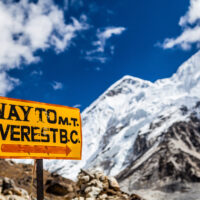Ladakh: The Land of High Passes
12.08.2011
This valley system in the high Himalaya is defined by the course of the Indus river as it flows from its source waters in Tibet. Roughly the size of Scotland, Ladakh is home to about 260,000 people, most in high-altitude settlements and some still living nomadically. It is the largest and least-populated region of the Indian province of Jammu and Kashmir, within one of the remotest corners of the Himalaya mountains.
Although politically the possession of India, Ladakh remains strongly influenced by the culture and religion of its Buddhist neighbors to the east and its Muslim neighbors to the west. Eastern Ladakh, where most tourism and climbing occurs, has been a center of Buddhist teaching since the 3rd century, A.D. and until the annexation of Tibet by China, Tibet was the home of Ladakhi religious training. The continuing influence of Tibetan culture is felt here in a variety of ways: the nearly identical architecture; the strong presence of Tibetan practices in Ladakhi religious life; the absence of rigid class structures commonly found elsewhere in India, and the higher status and social freedom afforded to women. All of these factors make it easy for visitors to see why the area is widely known as “Little Tibet.”
When the Silk Road was in use between 200 BC and 1400 AD, Ladakh represented a rare point of connection between Central Asia and South Asia. As late as the 1870s, traders continued to travel on a two-month journey over 11 passes connecting Ladakh to Amritsar and Yarkand. In the 1850s recreational trekkers began to share these trade routes, and slowly Ladakh became a popular destination for European explorers. Today the nomadic tradition flourishes in Ladakh, with literally dozens of high mountain routes ranging from easy trips of a few days in length to strenuous journeys lasting months.
The climbing opportunities waiting in Ladakh are limited only by the climber’s own reserves of time, experience, and inclination. While no mountains here reach the record heights found in other parts of the Himalayas, Ladakh gives climbers a wealth of options for their first or 40th Himalayan summit above 20,000 feet, involving as much or little technical challenge as desired.
Zanskar: the Crown of Ladakh
Sandwiched between the Zanskar and Himalaya mountains, the Zanskar valley is formed by a river of the same name and its tributaries. It is one of the highest, coldest, and remotest places in the world to be inhabited year-round by humans, with elevations beginning at over 11,000 feet and winter temperatures commonly reaching -22 Fahrenheit.
Despite its extreme remoteness, Zanskar is one of the more populous Buddhist valleys in this high-mountain region. Approximately 10,000 people live in the villages, farms and gompas (fortified monastery schools) spread out across the valley.
There is no easy way to get to Zanskar. In winter the valley is buried beneath thick snow and is almost completely cut off from the outside world. Some locals, and increasingly more adventurers, trek on the frozen Zanskar River to get in and out. In summer, you can take the 14-hour drive up the Suru river to Pensi-La (“Gateway to Zanskar”) or you can go by foot over one of the other nine high mountain passes that ring the valley. An ancient network of trade routes links these mountain passes together and crisscrosses the valley floor below. This network is still being used today, and forms the backbone of a world-class system of trekking routes.



